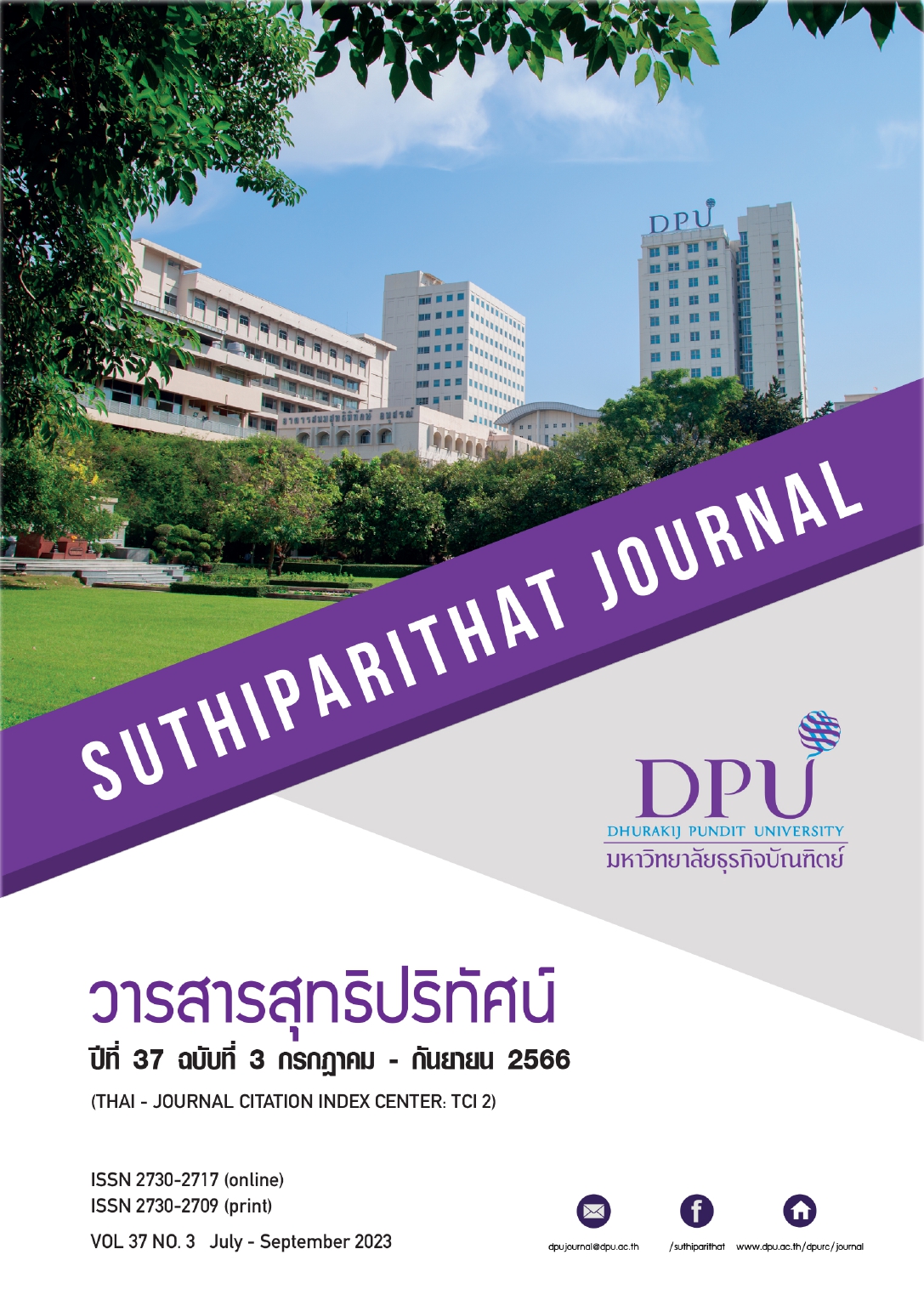FACTORS AFFECTING TOURISTS’ INTENTION TOWARDS CREATIVE COMMUNITY-BASED TOURISM IN SONGKHLA PROVINCE
Keywords:
Creative Community-Based Tourism, Theory of Planned Behavior, Service Marketing MixAbstract
The purpose of this research was to study the influence of attitude, subjective norms, perceived behavioral control, and the service marketing mix on the tourists’ intention towards creative community-based tourism in Songkhla province. The sample was 400 tourists selected by the multi-stage sampling. Data were collected using self-administered onsite and online questionnaires. Multiple linear regression analysis was employed to test the hypotheses. Results showed that attitude, subjective norms, and perceived behavioral control had a statistical positive influence on creative community tourism intentions at 01 level of significance with the standardized coefficient (β) value of .42 (t = 9.84), .30 (t = 6.79), .19 (t = 3.83) respectively. Attitude, subjective norms, and perceived behavioral control could explain 64%. of variance in the tourists’ intention towards creative community-based tourism in Songkhla province.
References
กรมการปกครอง, สำนักบริหารการทะเบียน. (2565). สถิติประชากรทางการทะเบียนราษฎร (รายเดือน) เดือนกรกฎาคม 2565. https://stat.bora.dopa.go.th/stat/statnew/statMONTH/statmonth/#/mainpage
กระทรวงการท่องเที่ยวและกีฬา. (2560). คู่มือการบริหารจัดการแหล่งท่องเที่ยวเชิงสร้างสรรค์. ผู้แต่ง.
กระทรวงการท่องเที่ยวและกีฬา. (2565, 23 มกราคม). สถานการณ์การท่องเที่ยวในประเทศ รายจังหวัด ปี 2565. https://www.mots.go.th/news/category/657
จิรดาภา สนิทจันทร์. (2564). ปัจจัยที่มีผลต่อการตัดสินใจท่องเที่ยวเชิงนิเวศของนักท่องเที่ยว กรณีศึกษาตลาดน้ำ บางน้ำผึ้ง จังหวัดสมุทรปราการ [รายงานการค้นคว้าอิสระปริญญามหาบัณฑิต, สถาบันบัณฑิตพัฒนบริหารศาสตร์]. คณะบริหารการพัฒนาสิ่งแวดล้อม สถาบันบัณฑิตพัฒนบริหารศาสตร์ (นิด้า). https://gseda.nida.ac.th/academics/database/students/fileupload/isdocument/20211020104710.pdf
จิราพร คงรอด, วาสนา สุวรรณวิจิตร, นิจกานต์ หนูอุไร, อรศิริ ลีลายุทธชัย, และ อัตถพงศ์ เขียวแกร. (2561). การวิเคราะห์พฤติกรรมและความต้องการของนักท่องเที่ยวที่มีต่อการท่องเที่ยวเชิงสร้างสรรค์ในพื้นที่ชุมชนลุ่มน้้าคลองป่าพะยอม – คลองท่าแนะ จังหวัดพัทลุง [รายงานผลการวิจัย, สำนักงานคณะกรรมการส่งเสริมวิทยาศาสตร์ วิจัยและนวัตกรรม]. สำนักงานคณะกรรมการส่งเสริมวิทยาศาสตร์ วิจัยและนวัตกรรม.
ชิดชม กันจุฬา. (2563). ปัจจัยที่มีอิทธิพลต่อความตั้งใจในการมาท่องเที่ยวซ้ำของนักท่องเที่ยว กรณีศึกษาเกาะเกร็ด จังหวัดนนทบุรี. วารสารเพื่อการพัฒนาการท่องเที่ยวสู่ความยั่งยืน, 2(1), 13-33. https://so04.tci-thaijo.org/index.php/JSTD/article/view/254911
ณัฏฐพัชร มณีโรจน์. (2561). ความสัมพันธ์ระหว่างภาพลักษณ์แหล่งท่องเที่ยว คุณภาพบริการ ความพึงพอใจ และความตั้งใจเชิงพฤติกรรมของนักท่องเที่ยวที่เดินทางท่องเที่ยว. วารสารวิชาการศรีปทุม ชลบุรี, 15(2), 117-130. https://so05.tci-thaijo.org/index.php/SPUCJ/article/view/190089
พิธารัตน์ สุขะนินทร์. (2561). การศึกษาการรับรู้ข้อมูล ทัศนคติ และพฤติกรรม ที่มีต่อการตัดสินใจท่องเที่ยวเชิงวัฒนธรรมของนักท่องเที่ยวชาวไทยในเขตกรุงเทพมหานคร [การค้นคว้าอิสระปริญญามหาบัณฑิต, มหาวิทยาลัยกรุงเทพ]. DSpace at Bangkok University. http://dspace.bu.ac.th/jspui/handle/123456789/4370
สุดแดน วิสุทธิลักษณ์. (2558). องค์ความรู้ว่าด้วยการท่องเที่ยวเชิงสร้างสรรค์: คู่มือและแนวทางปฏิบัติ. คณะสังคมวิทยาและมานุษยวิทยา มหาวิทยาลัยธรรมศาสตร์.
อรจันทร์ ศิริโชติ. (2556). การตลาดบริการ. นำศิลป์.
Ajzen, I. (1985). From intentions to actions: A theory of planned behavior. In J. Kuhl, and J. Beckmann (Eds.), Action control. SSSP Springer Series in Social Psychology. Springer. https://doi.org/10.1007/978-3-642-69746-3_2
Ajzen, I. (1991). The theory of planned behavior. Organizational Behavior and Human Decision Processes, 50(2), 179-211. https://doi.org/10.1016/0749-5978(91)90020-T
Ajzen, I. (2011). The theory of planned behaviour: Reactions and reflections. Psychology & Health, 26, 1113-1127. http://dx.doi.org/10.1080/08870446.2011.613995
Ajzen, I., Fishbein, M. (1991) The influence of attitudes on behavior. In D. Albarracin, B. T. Johnson, and M. P. Zana (Eds.), The handbook of attitudes (p. 32)
Faul, F., Erdfelder, E., Lang, A. G., & Buchner, A. (2007). G* Power 3: A flexible statistical power analysis program for the social, behavioral, and biomedical sciences. Behavior Research Methods, 39(2), 175-191. https://doi.org/10.3758/BF03193146
Fishbein, M., & Ajzen, I. (1975). Belief, attitude, intention and behavior: An introduction to theory and research. Addison-Wesley.
Fishbein, M., & Ajzen, I. (2011). Predicting and changing behavior: The reasoned action approach. Psychology press. https://doi.org/10.4324/9780203838020
Hodgkinson, C. (1996). Administrative philosophy: Values and motivations in administrative life. Pergamon Press.
Joo, Y., Seok, H., & Nam, Y. (2020). The moderating effect of social media use on sustainable rural tourism: A theory of planned behavior model. Sustainability, 12(10), 4095. http://dx.doi.org/10.3390/su12104095
Kotler, P., Keller, K. L., & Chernev, A. (2022). Marketing management (16th ed.). Pearson.
Voss, D. S. (2004). Multicollinearity. In Kimberly Kempf-Leonard (Ed.), The encyclopedia of social measurement (pp. 759–770). https://doi.org/10.1016/B0-12-369398-5/00428-X
Downloads
Published
How to Cite
Issue
Section
License
Copyright (c) 2023 Dhurakij Pundit University

This work is licensed under a Creative Commons Attribution-NonCommercial-NoDerivatives 4.0 International License.
Content and information of the article published at Suthiparithat Journal are based on the sole opinions and responsibility of author(s) only. Neither the editorial board involve in......







